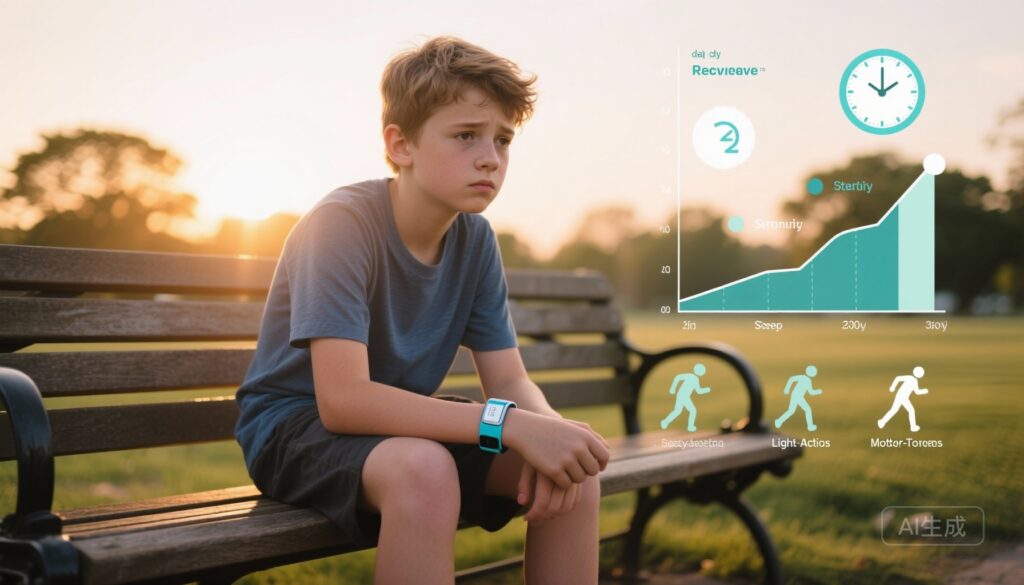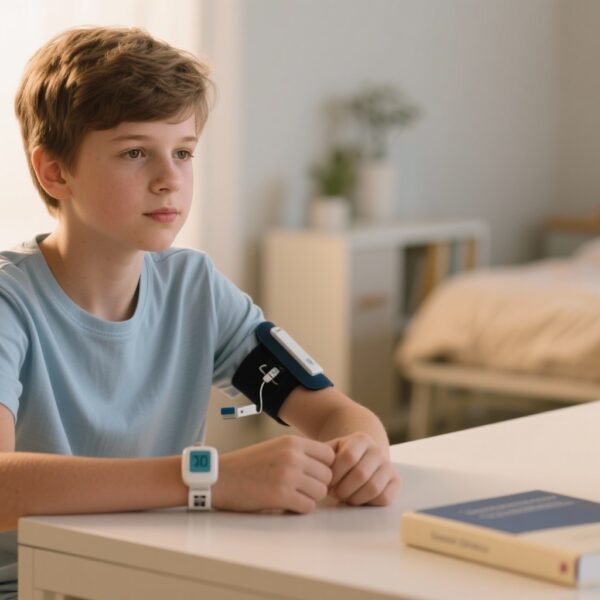Highlights
• In 259 children and adolescents with recent concussion, compositional analysis of 13 days of accelerometer data identified an optimal daily distribution of sleep, sedentary time, light physical activity (LPA) and moderate-to-vigorous physical activity (MVPA) associated with lower symptom scores at 2 weeks.
• Optimal recovery patterns trended from relatively more rest (sleep and sedentary time) early (day 2) toward increasing light activity later (around day 10), while MVPA was consistently above the cohort average across days.
• Findings support contemporary guidance favoring a short period of rest followed by a progressive return to activity, and offer a data-driven template for balancing sleep, sedentary behaviour and graded activity in pediatric concussion management.
Background: clinical context and unmet need
Concussion is a frequent and heterogenous injury in childhood and adolescence. Most young people recover within weeks, but a substantial minority experience persisting postconcussion symptoms (PPCS) that impact school, sport and quality of life. Clinicians and families commonly ask how much rest is needed and when/how to reintroduce activity. Historically, prolonged strict rest was recommended; more recent guidance emphasizes a brief period of cognitive and physical rest (typically 24–48 hours) followed by a gradual, symptom-guided return to activity. However, precise, evidence-based targets for daily sleep, sedentary time, light activity and moderate-to-vigorous physical activity (collectively, movement behaviours) during recovery remain undefined. The PedCARE secondary analysis by Kuzik et al. addresses this gap using compositional data methods to identify daily movement distributions associated with lower symptom burden at 2 weeks post-injury.
Study design and methods
This report is a secondary analysis of the Paediatric Concussion Assessment of Rest and Exertion (PedCARE) cohort (Kuzik et al.). Key elements:
- Population: 259 participants aged 10 to <18 years presenting to an emergency department with acute concussion (>48 hours after presentation). Mean age 13.3 years; 45% female.
- Outcome: Concussion symptom burden was measured using the Health and Behaviour Inventory (HBI) at approximately 2 weeks post-ED visit. Persisting symptoms after concussion (PSAC) were defined using reliable change in total HBI scores.
- Exposure: Objective measurement of daily movement behaviours (sleep, sedentary time, light physical activity, moderate-to-vigorous physical activity) using accelerometers across 13 days.
- Analysis: Compositional regression models were built for each day (days 1–13) to determine the optimal distribution of the 24-hour day across movement behaviours that predicted lower HBI scores and reduced probability of PSAC. Compositional data analysis accounts for the co-dependent nature of time-use data (the 24 hours are constrained and reallocations among behaviours are interdependent).
Key findings
The analysis produced day-specific “optimal” time allocations for sleep, sedentary behaviour, light physical activity and MVPA associated with lower symptom scores and lower probability of PSAC. Principal results were:
- Overall pattern: Early in recovery (eg, day 2) the optimal composition favored relatively greater sleep and sedentary time compared with the cohort mean. As recovery progressed across the 13 days, the optimal composition shifted to include more light physical activity, while MVPA tended to be above the cohort average consistently across days.
- Representative values reported by the authors (optimal vs average): On day 2, optimal allocations included about 11.5 hours/day of sleep (95% CI 8.8 to 12.7) and 8.5 hours/day sedentary (95% CI 6.5 to 11.3). Across multiple days (eg, days 2, 7, 13), MVPA in optimal patterns exceeded the average (day 2: 0.6 h/day [95% CI 0.2 to 1.2]; day 7: 1.5 h/day [95% CI 1.2 to 1.7]; day 13: 1.1 h/day [95% CI 0.2 to 1.7]). Increased light physical activity emerged as optimal later in recovery (eg, day 10: 5.5 h/day [95% CI 5.0 to 5.8]).
- Clinical outcome link: These optimal day-by-day compositions were associated with lower mean HBI scores and a reduced modeled probability of PSAC at 2 weeks compared with the cohort average composition.
Quantitative context and effect sizes
The study reports optimal behaviour estimates with 95% confidence intervals for specific days; however, because the analysis models relative allocations across the 24-hour day, the results are best interpreted as directional and compositional rather than simple independent effects of single behaviours. The analyses suggest that modest increases in MVPA (from, for example, less than an hour to around 1–1.5 hours/day) together with timing shifts—more rest early, more LPA later—relate to better short-term symptom outcomes.
Interpretation and clinical implications
These results align with and extend current practice recommendations in several ways:
- Short early rest supported: The finding that optimal compositions include relatively more sleep and sedentary time very early after injury aligns with contemporary guidance endorsing a brief period of rest (commonly 24–48 hours) after concussion to allow for initial symptom stabilization.
- Progressive reintroduction of activity: The emergence of increased light activity later in recovery supports a symptom-guided, staged return to activity rather than prolonged strict rest. Increasing LPA may function as a safe bridge to more demanding activity.
- Role of MVPA: Importantly, the optimal compositions typically included above-average MVPA across days, suggesting that controlled, probably sub-symptom-threshold MVPA is not only safe but potentially beneficial for symptom resolution when incorporated appropriately. This is concordant with emerging literature showing benefits of early, controlled aerobic conditioning for some patients with persistent symptoms (sub-symptom threshold exercise therapy).
- Practical application: Clinicians can use these compositional insights to counsel families on a balanced, time-based approach: endorse adequate sleep and reduced cognitive/physical load early, monitor symptoms, progressively increase light daily activities (walking, light household activities) within symptom limits, and plan short sessions of MVPA when tolerated, guided by symptom thresholds and clinical judgement.
Strengths and methodological notes
Key strengths include objective, continuous measurement of movement behaviours with accelerometry across nearly two weeks, a relatively large pediatric sample, and use of compositional data analysis which appropriately handles the co-dependence of time-use variables. The day-by-day modeling offers clinically relevant temporal insight into how optimal distributions may change during the early recovery window.
Limitations and cautions
- Observational, not interventional: The analysis establishes associations between movement compositions and symptom outcomes; it cannot prove causality. Children who recovered faster might naturally resume activity earlier, confounding directionality.
- Secondary analysis and selection: Being a secondary analysis of PedCARE, findings depend on the original cohort characteristics and study procedures; generalizability to younger children (<10 years), more severe injuries, or different settings may be limited.
- Accelerometer and classification limits: Accelerometers infer activity intensity and may misclassify some behaviours (eg, cycling, resistance exercise, or quiet wakefulness vs sleep). Distinguishing restorative rest from sedentary activities with cognitive load (eg, screen time or studying) is important clinically but was not granularly assessed here.
- Outcome timing: The primary outcome was symptom burden at ~2 weeks. Whether these compositional patterns predict longer-term outcomes (eg, 1–3 months) is uncertain.
- Inter-individual variability: Optimal group-level compositions may not suit every patient; clinical phenotypes (vestibular, oculomotor, migraine-like) may require tailored activity prescriptions.
How this fits with existing guidance and evidence
Contemporary consensus (International Concussion in Sport Group, 2017) and pediatric guidance (American Academy of Pediatrics clinical report) recommend brief rest followed by a graded return to activity tailored by symptoms. The PedCARE compositional findings provide objective, time-use–based nuance to this framework by quantifying how sleep, sedentary time and different intensities of activity might be balanced over the first two weeks to associate with lower symptom burden. While consistent with the directional guidance of these documents, the new data offer a more granular, empirically derived pattern to inform recommendations and future trials.
Research and practice implications
Future directions include:
- Randomized trials that manipulate daily movement compositions (eg, prescribed LPA and structured MVPA at sub-symptom thresholds) to test causality and clinical effectiveness.
- Longer follow-up to assess whether early compositional patterns influence risk of PPCS at 1–3 months or functional outcomes (school attendance, quality of life).
- Phenotype-specific work to determine if different injury or symptom profiles require distinct movement prescriptions.
- Integration of wearable monitoring into clinical pathways to support individualized, adaptive activity plans with remote symptom tracking.
Conclusion
Kuzik et al. provide the first compositional analysis linking 24-hour movement patterns with early postconcussion symptom recovery in children and adolescents. The data support a balanced, time-distributed approach: modestly increased rest early after injury, followed by progressive increases in light activity and incorporation of above-average MVPA within symptom limits. These findings reinforce contemporary recommendations to avoid prolonged strict rest and to pursue a graded, symptom-guided return to activity, while offering a data-driven scaffold for clinicians and families to plan daily movement during recovery. Interventional trials are needed to translate these observational compositional targets into prescriptive clinical protocols.
Funding and trial registration
For funding, trial registration details and full methodological information refer to the primary PedCARE publication: Kuzik N et al., Br J Sports Med. 2025 (doi: 10.1136/bjsports-2025-110067).
References
1. Kuzik N, Sicard V, Tremblay MS, Davis A, Sangha G, Yeates KO, Zemek R, Ledoux AA; PERC PedCARE team. Optimal movement behaviours for postconcussion symptom recovery in children and adolescents: a compositional analysis of the PedCARE cohort. Br J Sports Med. 2025 Nov 4:bjsports-2025-110067. doi: 10.1136/bjsports-2025-110067. Epub ahead of print. PMID: 41192961.
2. McCrory P, Meeuwisse W, Dvorak J, et al. Consensus statement on concussion in sport—the 5th international conference on concussion in sport held in Berlin, October 2016. Br J Sports Med. 2017;51(11):838–847.
3. Halstead ME, Walter KD; Council on Sports Medicine and Fitness. Sport-Related Concussion in Children and Adolescents. Pediatrics. 2018;142(6):e20183058.
Thumbnail image prompt (AI)
A thoughtful, high-resolution editorial-style image: an adolescent sitting on a park bench at dawn wearing a wrist accelerometer, looking at a smartphone displaying activity charts; soft overlays show icons for sleep (moon), sedentary (chair), light activity (walking silhouette), and MVPA (running silhouette); gentle warm color palette, clinical but approachable tone.



